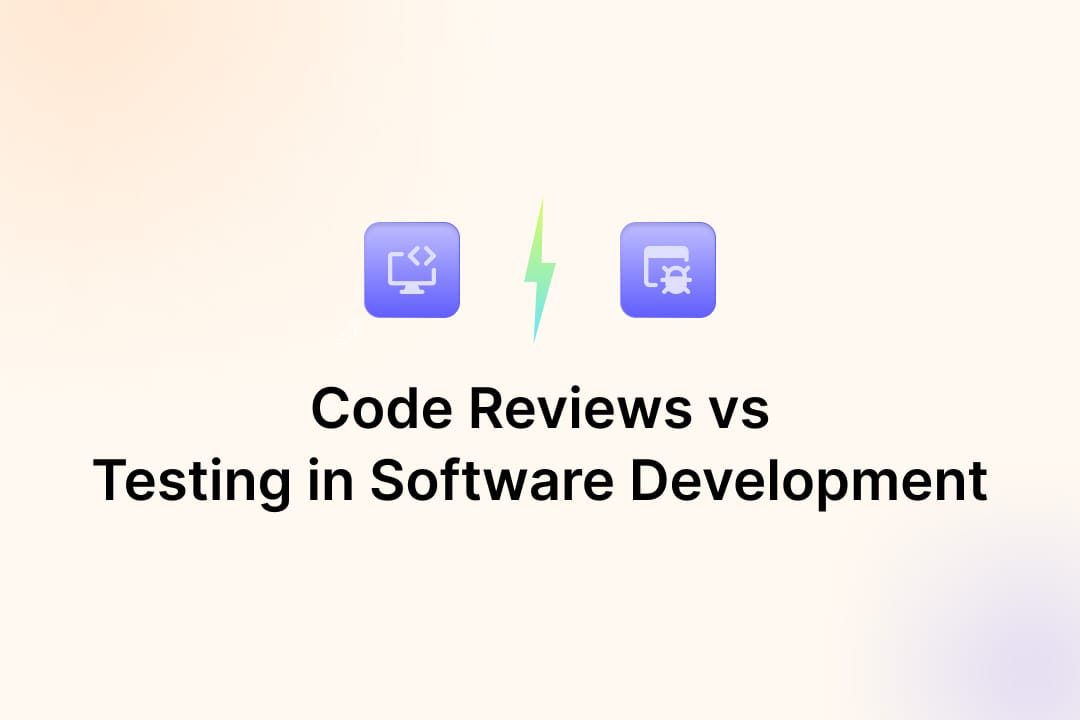Software bugs can be expensive, causing delays, frustrating users, and sometimes leading to serious financial or reputational damage. To prevent this, teams rely on two key practices: code reviews and testing. Both aim to improve software quality, but they have their own different ways of doing it. For example, testing verifies behavior through automated or manual checks, while code reviews involve human evaluation of logic, structure, and potential pitfalls. This blog explores how each method operates, where they differ, and how they complement one another, ultimately explaining why combining both leads to stronger, safer software.
What Is a Code Review?
A code review is the process of examining code changes before they are merged into the main codebase. This review can be done by a human or with the help of AI tools. The goal is to catch issues early, whether they’re bugs, design flaws, or inconsistencies with coding standards, and to improve the overall quality and maintainability of the code.
Typical Workflow
- A developer creates a pull request (PR) with code changes.
- One or more reviewers examine those changes.
- The feedback is shared through comments or suggestions.
- The developer (code author) makes revisions based on the feedback.
- Once approved, the code is merged into the main branch.
- Automated checks (like linters or tests) may run during the review.
Key Benefits
- It promotes knowledge sharing across the team.
- It identifies architectural or design issues early.
- It helps enhance best practices and follow coding standards.
- It improves long-term maintainability of the codebase.
- It encourages collaboration and collective ownership.
What Is Software Testing?
Software testing is the practice of checking if code behaves as expected. It works across different levels:
- Unit testing checks individual functions or components in isolation.
- Integration testing ensures that different modules work well together.
- System testing verifies the entire application as a whole.
- Acceptance testing confirms whether the software meets business or user requirements.
Each level adds a layer of confidence, from small pieces of code to full end-to-end behavior.
Manual vs Automated Testing
Manual testing is performed by humans, following predefined steps, to identify issues that automated tools might miss, such as visual bugs or unusual user flows. It's useful for exploratory testing or one-off cases.
Automated testing, on the other hand, is faster and repeatable. It’s best suited for continuously checking code, especially in CI/CD pipelines that often run in pre- and post-merge scenarios, and for catching regressions when features are changed.
Key Benefits
- Validates that the software works as intended.
- Helps catch regressions after new changes.
- Builds user and stakeholder confidence in product quality.
- Reduces the risk of bugs reaching production.
- Supports faster, safer releases over time.
Purpose and Scope: Key Differences Explained
- Focus
- Code Review: Looks at how code is written; its structure, readability, and alignment with standards.
- Testing: Checks if the code works as expected under different scenarios.
- Timing
- Code Review: Happens before the code is merged into the main branch.
- Testing: Happens after the code is built or deployed in a test environment.
- People and Tools Involved
- Code Review: Involves developers, often peers or AI assistants, using tools like GitHub Copilot, CodeRabbit, or Refacto.
- Testing: Involves developers and QA teams using automation tools such as JUnit, Selenium, or Cypress.
- Purpose
- Code Review: Prevents poorly written or logically flawed code from entering the codebase.
- Testing: Prevents functional failures and helps catch issues introduced during changes.
- Strength
- Code Review: Best at catching logic errors, design concerns, and encouraging good practices.
- Testing: Best at identifying bugs during runtime and ensuring existing features don’t break.
Where They Overlap, and Where They Don’t
Shared Goal: Prevent Defects Early
Both code reviews and testing aim to catch issues before they reach production. They serve as quality checkpoints that help teams deliver more stable software. Whether it’s a logic flaw or a hidden runtime bug, the goal is the same: identify problems early, when they’re easier and cheaper to fix.
Distinct Strengths
Code reviews are strong at catching structural and design issues. Reviewers can spot things like unclear logic, unnecessary complexity, or a missed edge case just by reading the code.
Testing, on the other hand, checks if the code behaves as expected when it runs. It can uncover runtime problems like incorrect outputs, failed API calls, or unexpected side effects that might not be obvious from the code alone.
Real-World Example: A Null-Pointer Bug
Imagine a developer forgets to check if a variable is null before using it.
- In a code review, a sharp reviewer might notice the missing null check and flag it. But if the code looks clean and the logic seems safe, it could be missed.
- In testing, especially with automated test cases that simulate different inputs, a null value might trigger a failure during execution. However, if no test covers that scenario, it could slip through.
When to Prioritize Each
Early-Stage Projects: Lean Reviews, Lightweight Tests
In the early stages of a project, speed is often a priority. Code reviews help maintain basic code quality without slowing things down. These reviews can be informal; just a quick look by a teammate. Lightweight tests, like unit tests for core functions, are enough to catch obvious issues while keeping the development fast and flexible.
Scaling Teams: Formalized Reviews, Automated Test Pipelines
As teams grow, consistency becomes more important. Code reviews should follow clear guidelines, with multiple reviewers and structured checklists. At the same time, automated testing pipelines become essential. They ensure that every new change is checked for regressions and meets quality standards, even when dozens of developers are working in parallel.
Legacy Codebase: Testing for Safety Nets, Reviews for Refactors
Older codebase often comes with unknown risks. Writing tests helps create safety nets around existing functionality before making changes. Code reviews are especially useful when refactoring: reviewers can spot risky rewrites or missed dependencies. Together, testing and reviews reduce the chance of breaking something critical in code that may no longer be fully understood.
Can One Replace the Other in Real‑World Development?
Under tight deadlines or shifting priorities, it’s tempting for teams to lean heavily on either code reviews or testing, thinking one can cover for the other. But in practice, that’s the wrong choice. Each method shines in different areas and leaves gaps that the other fills. Relying on only one creates blind spots that can lead to bugs slipping through, often at the worst possible time.
The right balance often depends on context: how mature the product is, how often the releases go out, how sensitive the application is to failures, and what tools or resources the team has in place. There's no one-size-fits-all rule, but understanding what each method does (and doesn’t) identify helps teams make smarter trade-offs.
Can Code Reviews Replace Testing?
What Reviews Catch Well:
- Code structure and logic flow
- Clear, consistent naming and abstraction
- Alignment with security patterns and architectural goals
- Readability and maintainability for future developers
What Slips Without Tests:
- Runtime bugs and integration failures
- Environment-specific issues
- Race conditions and memory leaks
- Performance regressions or data format mismatches
- Inputs or edge cases not covered in review discussions
Human Factors Risk:
- Reviewer fatigue, especially on large diffs
- Subtle bugs in auto-generated or refactored code are often missed
- Assumptions are not questioned without executable proof
When Teams Rely More on Reviews:
- Early-stage products or fast-moving prototypes
- Startups without a mature testing framework
- Hotfixes where speed is critical
- Greenfield modules before the test scaffolding is ready
Safety Checklist if Testing Is Thin:
- Keep PRs small and focused
- Require clear reproduction steps in PRs
- Use lightweight smoke tests or feature toggles
- Monitor post-merge incidents closely
- Add logs or alerts to catch failures quickly
Reminder: If the only safety net is code review, defects show up in staging or, worse, in user telemetry.
Can Testing Replace Code Reviews?
What Tests Do Well:
- Prevent regressions across repeated releases
- Validate behavior across a wide range of inputs
- Check API contracts and backend/frontend interactions
- Catch performance drops and platform inconsistencies
What Slips Without Reviews:
- Dead or unused code
- Overcomplicated or unclear designs
- Security flaws that tests don’t trigger
- Duplicate logic or unclear naming
- Missing documentation or misleading intent
- Gaps in test coverage that give false confidence
Test Quality Depends on the Author:
- Poorly written or flaky tests can pass broken logic
- Over-mocking or shallow assertions miss deeper issues
- Automated checks don’t understand business intent
When Teams Rely More on Tests:
- CI/CD-heavy environments with fast iteration cycles
- Generated codebase (e.g., SDKs, APIs)
- Legacy systems wrapped in high-coverage tests
- Safety-critical software with strict compliance needs
Safety Checklist if Reviews Are Light:
- Enforce static analysis and linting on every branch
- Require threat models for sensitive areas
- Block merges on TODOs, FIXMEs, or insecure code
- Rotate test authors to uncover gaps and assumptions
Reminder: Green tests do not mean good code: just code that passes the scenarios someone thought to write.
Best Practices
For Code Reviews
- Set clear review guidelines so that everyone knows what to look for: logic, style, security, and consistency.
- Keep PRs small and focused to make reviews easier and reduce the chance of missing issues.
- Encourage constructive feedback that explains why changes are suggested, not just what to fix.
- Use AI-assisted tools to catch common issues automatically and free up reviewers to focus on deeper problems.
For Testing
- Follow a clear test pyramid, with more unit tests, fewer integration tests, and just enough end-to-end tests.
- Write meaningful assertions that check real outcomes, not just surface-level behavior.
- Maintain tests regularly to remove outdated ones, improve flaky cases, and adapt to new features.
Metrics to Watch
- Review turnaround time
- Why it matters: Keeps development flow smooth and avoids bottlenecks
- Target: Less than 1 business day
- Code coverage
- Why it matters: Reflects how much of the codebase is tested
- Target: Aim for 70–80% of lines, however, quality of the tests is equally important
- Defect escape rate
- Why it matters: Measures how many bugs make it to production
- Target: Should steadily trend downward over time
Conclusion
Code reviews and testing both have their own perks; each covers what the other might miss. Reviews catch design flaws, logic errors, and code quality issues early, while testing validates that software behaves correctly in real-world conditions. Relying on just one creates blind spots that can lead to costly bugs. Together, they offer broader protection and greater confidence. Teams should regularly audit their workflows, spot gaps, and make small, steady improvements to strengthen quality without slowing down delivery.


